
Victory Through Air Power (1943) fascinates me no end.
When I was growing up in the 1960s, 70s and 80s, this was the “lost” Disney feature (today Song Of The South might hold that honor). Nothing was written about it – nor could it be viewed (these were the days before DVD and VHS) – I don’t think it was ever offered on 16mm after the war and it certainly was never sold to TV or used (except for excerpts) on the Disneyland or Wonderful World of Color TV shows.

The Insert Poster
My seeing the film, many years later, felt like putting the final piece into a giant jigsaw puzzle. The film answered many questions and initiated a few more. I continued to do private research into this feature and ultimately was given the honor of introducing a restored 35mm print of Victory Through Air Power at a screening in 2004 (just prior to its Disney Treasures DVD release) at the Motion Picture Academy. For this, I was allowed access to the Disney Archive – and spent some of that access examining the film’s press book and other publicity materials.
I was particularly fascinated with the fact that United Artists released the film (as opposed to RKO). This was truly an “independent” film. Disney spent his own (or the studio’s own) money to make it. He had to shop for another distributor to release it. It was an animated documentary – about an contemporary issue that instantly dated the project.
But much good came to the studio as a result of its production. For one, it stretched the abilities of the artists and animators (particularly the effects animators) to tackle visuals the studio had not needed to illustrate or animate before – mammoth explosions, military hardware, realistic human figures, etc. The presentation of material – using Major Seversky in an office, with maps, globes and other visual aids, addressing the camera – foreshadows the very format that Disney would use to host ABC’s Disneyland, Walt Disney Presents and NBC’s The Wonderful World of Color.
Along with other films produced for the military, Victory Through Air Power would usher in a new era of creating educational films for the general public; industrial films for commercial clients, and instructional films for classroom use.
But how was this film marketed to the public? All films going through the standard distribution channels go through a certain process – a process that yields a trailer, posters and publicity. Without the famous Disney characters or a classic story, it must have been a challenge. And apparently it was.
The good news – in addition to the “Walt Disney” name, the film had the advantage of being based on a best-selling book. It was touted as an important film “that must be seen”. The marketing for this film was clearly different. It had to be – we were in a new world. The War was on. The country had a new focus. This film introduced ‘a new Disney’. A relevant Disney. It pioneered another route, a new road for animation. As dire as our situation was, the optimism for victory is quite present in these posters. Propagandistic to be sure, the advertising art was serious, powerful and strong.
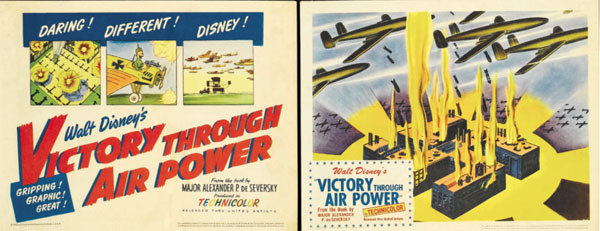
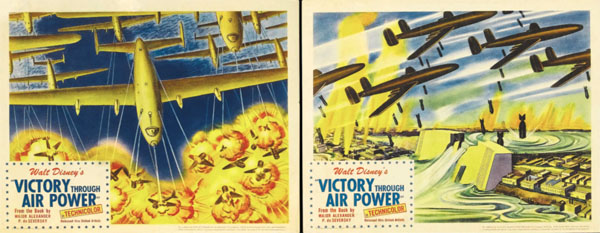
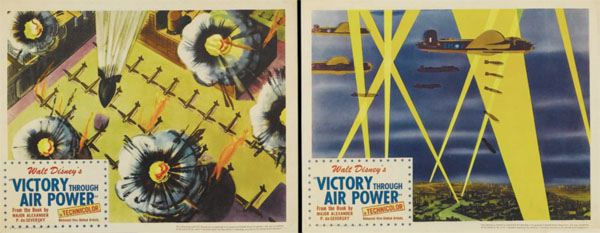
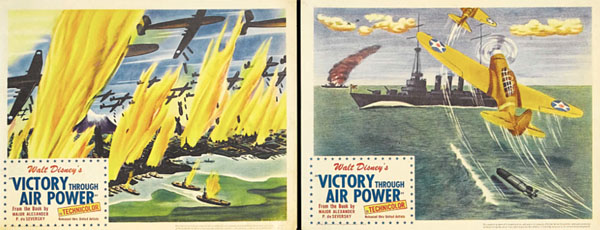
The Lobby Card set (above) – the one-sheet (below left) and the three sheet (below right):
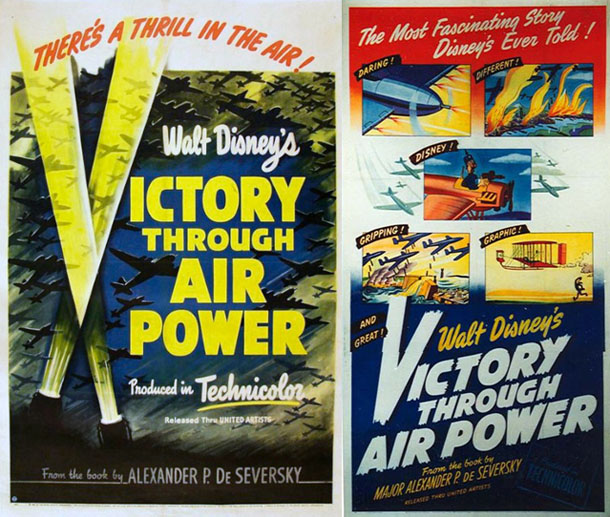
That didn’t mean they couldn’t enlist the standard characters (Mickey, Donald, Pluto, Goofy, etc) to help promote the picture. In fact, I don’t think they could help it. Here are two panels from one of the Good Housekeeping magazine pages Disney used to promote his latest features and shorts. (Please buy David Gerstein’s Mickey and The Gang to see a few other examples of how the studio used Mickey and comic pages to tie-into the film.):
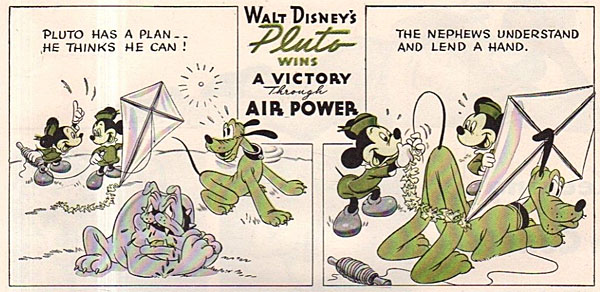
This leads me to these five stills I had in my collection for years… a series of cartoon images that might have been used in a magazine publicity spread. I haven’t seen these posted (or reprinted) anywhere… so I thought it would be a good idea to get them out there. I’m not the best at recognizing art styles of individual Disney artists, but these looks like Bill Justice to my untrained eye.
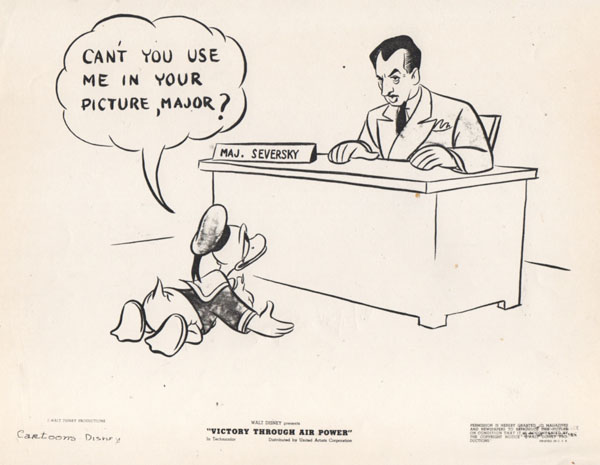
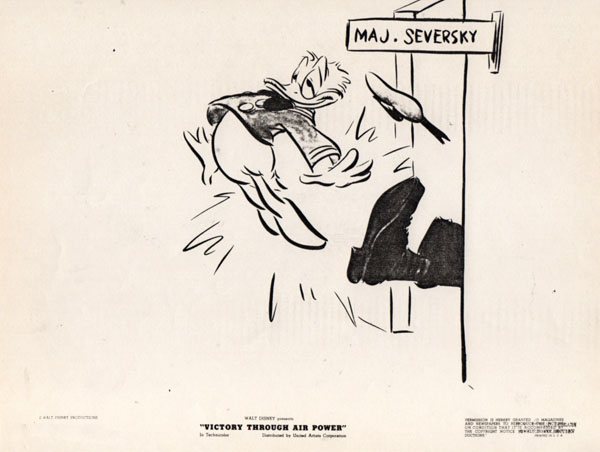
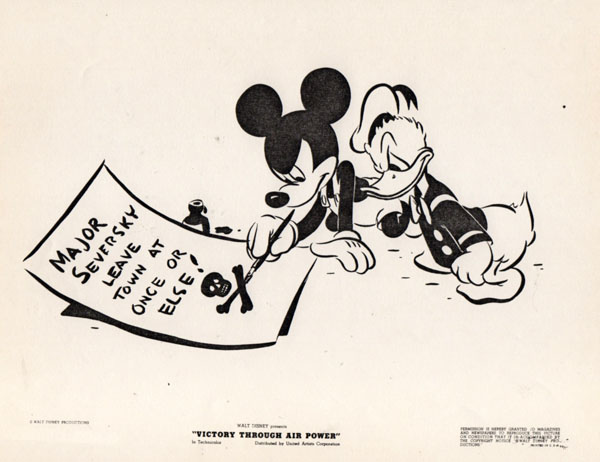
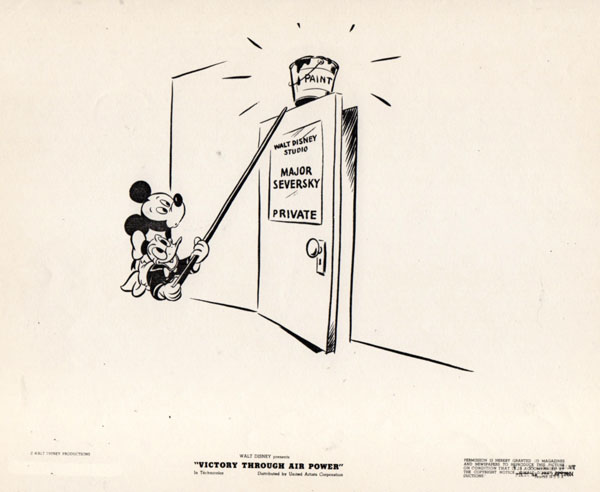
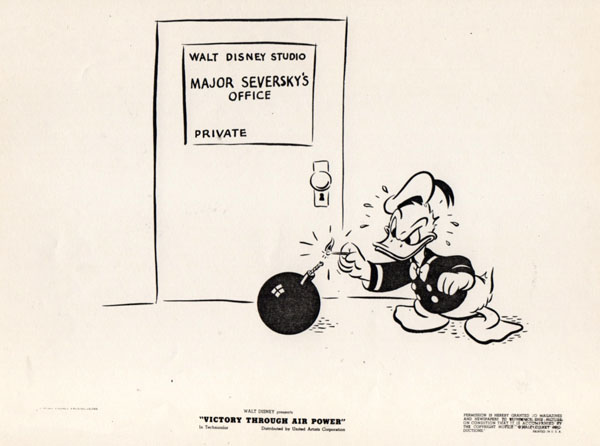


 Jerry Beck is a writer, animation producer, college professor and author of more than 15 books on animation history. He is a former studio exec with Nickelodeon Movies and Disney, and has written for The Hollywood Reporter and Variety. He has curated cartoons for DVD and Blu-ray compilations and has lent his expertise to dozens of bonus documentaries and audio commentaries on such. Beck is currently on the faculty of CalArts in Valencia, UCLA in Westwood and Woodbury University in Burbank – teaching animation history. More about Jerry Beck [
Jerry Beck is a writer, animation producer, college professor and author of more than 15 books on animation history. He is a former studio exec with Nickelodeon Movies and Disney, and has written for The Hollywood Reporter and Variety. He has curated cartoons for DVD and Blu-ray compilations and has lent his expertise to dozens of bonus documentaries and audio commentaries on such. Beck is currently on the faculty of CalArts in Valencia, UCLA in Westwood and Woodbury University in Burbank – teaching animation history. More about Jerry Beck [



































I love those five drawings of Donald begging and threatening Seversky!
The impact of this film was far-reaching in its day. If I remember the story correctly, Winston Churchill was greatly impressed by the film and he persuaded FDR, who had resisted watching it, to give it a viewing. Once the President had seen it, he was inspired to incorporate more air power into the military efforts, and this eventually led to victory for the Allies–an oversimplification to be sure, but to the best of my understanding this was the ultimate result.
Disney’s impact on WWII is now often glossed over, but he made significant contributions to the war effort–as indeed did all of the major studios in Hollywood. But though I didn’t live through the era and can’t say for sure, it seems to me looking back over all of the propaganda and publicity that emerged in those times, that Disney might possibly have been the most influential of all the Hollywood studios in helping to win the war.
Absolutely. This issue is forgotten when people continue the lie about Disney being a Nazi sympathizer. Just remind them of this. What’s most interesting is that most of the people making this statement were born years after Walt had passed away. So how could they ever know anything about what he was like, having never had the experience of seeing him on television as we did.
This was quite interesting. Jerry, did RKO simply decline to distribute VICTORY? UA’s involvement in releasing the picture has always fascinated me.
Excellent piece — those stills of the Duck and Mouse in revolt are priceless.
Did RKO specifically decline to distribute the picture? I would imagine that UA, having missed out on SNOW WHITE after Disney abruptly decided to switch its distribution to RKO (a complex issue), was enthusiastic about finally getting to release one of Walt’s animated features.
Based on my research – but admittedly I’d need to do more – RKO rejected VICTORY for the same reasons they later rejected The Living Desert… They believed Disney’s “brand” was animation and strictly of the standard stories. The last Disney experimental idea (Fantasia) didn’t fare too well for RKO. Disney borrowed the production money without the help of his regular distributor in place because he was passionate about communicating the film’s message. United Artists was uniquely set up to distribute a film such as this – handling independent productions by major producers was a UA mandate. Walter Lantz took advantage of this a few years later when he was in a pinch with Universal. I’ve a feeling Walt stayed in friendly communication with UA since his departure…
Great images! This was a different America 75 years ago… and a different Hollywood!
Great post on this “forgotten” film. Walt was risking future government contracts because some branches including the Navy, Disney’s biggest Armed Forces client, tried to talk Walt out of making the film because they disagreed with the premise. The Navy felt that battleships would win the war not airplanes.
Besides the opening history of aviation, there is also striking use of animation in the live action section including the memorable image of a Japanese octopus expanding its influence and being attacked by an American eagle to relinquish its territory from its tentacled grip. There had been some initial discussion in the planning stages to use Mickey Mouse and Donald Duck (to explain certain concepts) but as you point out they did appear in advertising and promotional material for the film.
The film lost $436,000 but Walt was convinced it was a film that needed to be made. Roy Disney stated, “We did it as a patriotic gesture”.
Prime Minister Winston Churchill was so impressed with the film that he had a copy brought by fighter jet to the Quebec Conference in August 1943 to show President Franklin D. Roosevelt. After seeing it, Roosevelt ordered the film to be shown to the Joint Chiefs of Staff and it undoubtedly help influence American air strategy in the rest of the war.
A polite question for Jim Korkis: A fighter JET? in 1943? The Allies had experimental jets at the time but I find it hard to understand that they would allow one to be used to transport a movie, even for Winston Churchill.
I do like the series of one-panel drawings of Mickey and Donald Duck trying to sabotage the Major; acting almost like their many animated rivals.
Fascinating.
I’ve become fixated with acquiring original art from this film for my collection because it represents the intersection of my personal hobby and profession.
I uncovered under a house (and just finished having restored) the Australian Daybill poster for ‘Victory’, which funnily enough was shown this side of the world as a double bill with Disney’s Saludos Amigos.
So the Disney crew is threatening Seversky?!